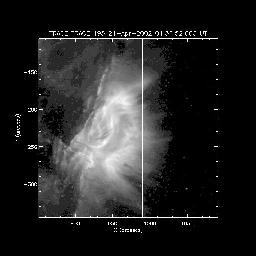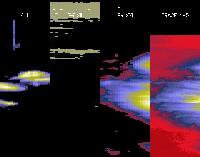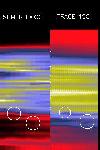Supra-arcade downflows in the April 21 flare
The X-class solar flare of 21 April 2002, described in a previous nugget, is a very recent example of downflows above a post-eruption coronal arcade ([1], [2], [3]), though now observed with TRACE for the first time. The higher spatial resolution of TRACE affords us a sharper view than was possible with Yohkoh/SXT. Fortunately, SoHO/SUMER was also watching this region when the flare erupted, so that some spectral data were obtained. In this nugget we compare the observations from the two telescopes -- this is a work in progress, and is currently being written up for publication.
The archetypical supra-arcade event was reported in an earlier nugget, as well as a paper by McKenzie and Hudson (1999). The flare was on 20-Jan-1999, and a movie is shown below, acquired by Yohkoh/SXT in half-resolution (4.9 arcseconds per pixel), one image per 20 seconds. The middle part of the post-eruption arcade is obscured by pixel saturation; above the arcade (to the left in these images) one can see dark features moving downwards. It's these features we call supra-arcade downflows (or SADs -- apologies for the unimaginative name.) The little arrows are intended to draw your eye to the locations of the downflows.
These kinds of downflows have been seen in more than thirty flares, but until now they've only been seen by SXT. The speeds have been between 50-500 km/s, and apparently there are also some X-ray-bright shrinking features in the same region. But the big question remains, What are they?
As we reported earlier, the X-class flare of 21-Apr-2002 had supra-arcade downflows -- you can see these in the movie below. Look for the dark wiggly features in the southern part of the fan above the arcade.
|
Large (350 kb) |
|
Huge (1.2 Mb) |
We note at this point that the supra-arcade region is very hot, and that these TRACE images show plasmas of two temperatures: 1.5 MK (due to Iron XII in the main part of the arcade), and 15 MK (due to Iron XXIV in the fan above the arcade).
Because this flare occurred during a Max Millennium observing campaign, many observatories caught the action. One of these was SUMER on SoHO. The position of the SUMER slit is shown in the image below, and happily it lies across the supra-arcade fan. Consequently, SUMER intercepted some of the downflows, and we are able to look for signatures of SADs in a few different temperatures.

SUMER recorded signals in three different ions: Carbon II, Iron XII, and Iron XXI. These are characteristic of three very different temperatures: 23,000 kelvins, 1.5 MK, and 10 MK, respectively (begging forgiveness from the spectroscopists and atomic physicists). So in this event, SUMER was able to look in the downflows for plasma of these temperatures. What do we see?
In the plots below, we display the signal along the SUMER slit for several different times. The slit-images for successive times are stacked up side-by-side, so time runs from left to right; north is up, south is down. The fourth panel shows the TRACE data from the slit position, in the same format.

As dark SADs cross the slit, they appear as dark features in the time-space plots. Two such features are circled in the image below -- only for the SUMER Fe XXI and TRACE data, since nothing at all is seen in the C II or Fe XII data.

The conclusion here is that the SADs seem to be dark in all four of the temperature regimes represented here. This has implications for the makeup of the dark features. For example, if they are blobs with a temperature near 25,000 kelvins, then they should be visible in the C II data. By sampling several temperatures at once, we can put some rather tight limits on the nature of the downflows.
So again, what are they? The lack of emission in all these different temperatures doesn't exactly rule out the possibility that these are dense clumps of plasma, but it doesn't really support the idea either. Add in the fact that the clumps would have to be really, really dense in order to block out all the X-rays in the SXT images, and the "dense clump" idea looks even less appealing.
Another possibility is that the SADs are dark because they are empty regions. This is a strange kind of beast too, because the only force we have for excluding hot plasma from a place is magnetism. The earlier nugget suggested an arrangement of magnetic structures that might explain the supra-arcade downflows in terms of reconnection outflow; but at this point we can only say that we don't know yet.
July 19, 2002
David McKenzie (mckenzie@mithra.physics.montana.edu), Davina Markiewicz-Innes, Tong Jiang Wang